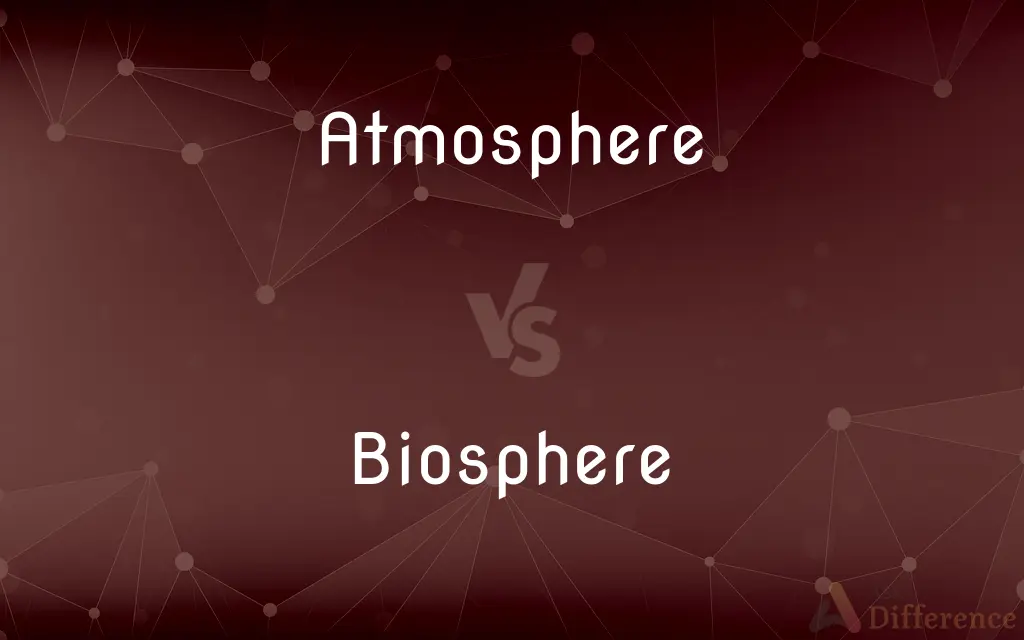Atmosphere vs. Biosphere — What's the Difference?
By Maham Liaqat & Fiza Rafique — Updated on March 15, 2024
The atmosphere is the layer of gases surrounding Earth, crucial for climate and weather patterns, whereas the biosphere encompasses all living organisms and their interactions with the environment.

Difference Between Atmosphere and Biosphere
Table of Contents
ADVERTISEMENT
Key Differences
The atmosphere is a complex layer of gases that envelops the Earth, playing a critical role in protecting life by absorbing ultraviolet solar radiation and reducing temperature extremes between day and night. Whereas the biosphere refers to the global ecological system integrating all living beings and their relationships, including their interactions with the elements of the lithosphere, hydrosphere, and atmosphere.
While the atmosphere is composed primarily of nitrogen (78%) and oxygen (21%), with smaller amounts of other gases, the biosphere is made up of countless ecosystems, each with a diverse array of life forms adapted to their specific environments.
On one hand, the atmosphere's structure is divided into layers based on temperature variations, including the troposphere, stratosphere, mesosphere, thermosphere, and exosphere. On the other hand, the biosphere is not defined by a physical structure but by the presence of life in various forms, from the deepest parts of the ocean to the highest mountains.
The atmosphere plays a crucial role in the Earth's water cycle and climate system, influencing weather patterns and climate change. In contrast, the biosphere is essential for the production of oxygen through photosynthesis, which is crucial for life and affects atmospheric composition.
Atmospheric phenomena, such as the greenhouse effect, are critical for maintaining the Earth's temperature. Meanwhile, the biosphere influences and is influenced by these phenomena, demonstrating the interconnectedness of Earth's systems.
ADVERTISEMENT
Comparison Chart
Definition
The layer of gases surrounding a planet.
The global sum of all ecosystems, including all life forms.
Composition
Mainly nitrogen and oxygen, with trace amounts of other gases.
Various ecosystems with living organisms and their physical environment.
Role
Protects life from solar radiation, maintains temperature.
Supports all life, involves interactions among organisms and their environments.
Layers/Structure
Divided into troposphere, stratosphere, mesosphere, thermosphere, and exosphere.
Distributed across diverse habitats, from oceans to mountains, without distinct layers.
Impact on Earth
Influences climate, weather patterns, and protects against solar radiation.
Produces oxygen, contributes to the carbon cycle, and impacts atmospheric composition.
Compare with Definitions
Atmosphere
The envelope of gases surrounding Earth.
The Earth's atmosphere is crucial for weather patterns and climate.
Biosphere
The global ecological system integrating all living beings and their relationships.
The biosphere encompasses diverse ecosystems, from forests to coral reefs.
Atmosphere
A layer protecting living organisms from ultraviolet solar radiation.
The ozone layer in the atmosphere filters harmful UV radiation.
Biosphere
Includes all ecosystems and living organisms, interacting with the lithosphere, hydrosphere, and atmosphere.
Trees in the biosphere absorb CO2, influencing the atmosphere's composition.
Atmosphere
Composed primarily of nitrogen and oxygen.
Nitrogen makes up about 78% of the Earth's atmosphere.
Biosphere
Essential for the production of oxygen through photosynthesis.
The biosphere's plants and algae are crucial oxygen producers.
Atmosphere
Divided into several layers based on temperature variations.
The stratosphere is the second layer of the atmosphere, above the troposphere.
Biosphere
Affects and is affected by the Earth's physical and chemical environments.
Changes in the biosphere can impact climate patterns.
Atmosphere
The medium for meteorological phenomena like rain and snow.
The atmosphere's moisture content determines precipitation levels.
Biosphere
Comprised of diverse habitats, from the deepest oceans to the highest mountains.
The biosphere's range extends to the Mariana Trench and Mount Everest.
Atmosphere
An atmosphere (from the greek words ἀτμός (atmos), meaning 'vapour', and σφαῖρα (sphaira), meaning 'ball' or 'sphere') is a layer or a set of layers of gases surrounding a planet or other material body, that is held in place by the gravity of that body. An atmosphere is more likely to be retained if the gravity it is subject to is high and the temperature of the atmosphere is low.
Biosphere
The biosphere (from Greek βίος bíos "life" and σφαῖρα sphaira "sphere"), also known as the ecosphere (from Greek οἶκος oîkos "environment" and σφαῖρα), is the worldwide sum of all ecosystems. It can also be termed the zone of life on Earth.
Atmosphere
The gaseous mass or envelope surrounding a celestial body, especially the one surrounding the earth, and retained by the celestial body's gravitational field.
Biosphere
The part of the earth and its atmosphere in which living organisms exist or that is capable of supporting life.
Atmosphere
The air or climate in a specific place.
Biosphere
The living organisms and their environment composing the biosphere.
Atmosphere
Abbr. atm Physics A unit of pressure equal to the air pressure at sea level. It equals the amount of pressure that will support a column of mercury 760 millimeters high at 0 degrees Celsius under standard gravity, or 14.7 pounds per square inch (1.01325 × 105 pascals).
Biosphere
The part of the Earth and its atmosphere capable of supporting life.
Atmosphere
A dominant intellectual or emotional environment or attitude
An atmosphere of distrust among the electorate.
Biosphere
The totality of living organisms and their environment.
Atmosphere
The dominant tone or mood of a work of art.
Biosphere
The regions of the surface and atmosphere of the Earth (or other planet) where living organisms exist
Atmosphere
An aesthetic quality or effect, especially a distinctive and pleasing one, associated with a particular place
A restaurant with an Old World atmosphere.
Atmosphere
The gases surrounding the Earth or any astronomical body.
Atmosphere
The air in a particular place.
Atmosphere
The conditions (such as music, illumination etc.) that can influence the mood felt in an environment.
Atmosphere
The apparent mood felt in an environment.
Atmosphere
A unit of measurement for pressure equal to 101325 Pa (symbol: atm)
Atmosphere
Extras in a scene who have no spoken lines.
Atmosphere
The whole mass of aëriform fluid surrounding the earth; - applied also to the gaseous envelope of any celestial orb, or other body; as, the atmosphere of Mars.
An atmosphere of cold oxygen.
Atmosphere
A supposed medium around various bodies; as, electrical atmosphere, a medium formerly supposed to surround electrical bodies.
Atmosphere
The pressure or weight of the air at the sea level, on a unit of surface, or about 14.7 lbs. to the sq. inch.
Hydrogen was liquefied under a pressure of 650 atmospheres.
Atmosphere
Any surrounding or pervading influence or condition.
The chillest of social atmospheres.
Atmosphere
The portion of air in any locality, or affected by a special physical or sanitary condition; as, the atmosphere of the room; a moist or noxious atmosphere.
Atmosphere
A particular environment or surrounding influence;
There was an atmosphere of excitement
Atmosphere
A unit of pressure: the pressure that will support a column of mercury 760 mm high at sea level and 0 degrees centigrade
Atmosphere
The mass of air surrounding the Earth;
There was great heat as the comet entered the atmosphere
It was exposed to the air
Atmosphere
The weather or climate at some place;
The atmosphere was thick with fog
Atmosphere
The envelope of gases surrounding any celestial body
Atmosphere
A distinctive but intangible quality surrounding a person or thing;
An air of mystery
The house had a neglected air
An atmosphere of defeat pervaded the candidate's headquarters
The place had an aura of romance
Common Curiosities
What is the biosphere?
The biosphere encompasses all living organisms and their interactions with the environment.
What are some components of the biosphere?
The biosphere includes ecosystems, organisms, and their interactions with the environment.
How does the biosphere affect the atmosphere?
The biosphere produces oxygen through photosynthesis and contributes to the carbon cycle, affecting atmospheric composition.
What is the atmosphere?
The atmosphere is the layer of gases surrounding Earth, crucial for climate and weather patterns.
How do the atmosphere and biosphere interact?
They interact through processes like photosynthesis, where plants in the biosphere produce oxygen that becomes part of the atmosphere.
What are the layers of the atmosphere?
The layers include the troposphere, stratosphere, mesosphere, thermosphere, and exosphere.
How does the biosphere contribute to the Earth's carbon cycle?
Organisms in the biosphere absorb and release carbon, playing a key role in the carbon cycle.
What gases are predominant in the atmosphere?
Nitrogen (78%) and oxygen (21%) are the predominant gases in the atmosphere.
Can life exist outside the biosphere?
Life as we know it is adapted to conditions within the biosphere and would struggle to survive outside of it.
What is the relationship between the atmosphere's layers and climate?
The structure of the atmosphere's layers influences temperature, weather patterns, and climate on Earth.
How does the atmosphere protect Earth?
It absorbs ultraviolet solar radiation and reduces temperature extremes between day and night.
How does climate change impact the biosphere and atmosphere?
Climate change can alter habitats, affect species distribution in the biosphere, and disrupt atmospheric patterns.
What is the importance of the ozone layer in the atmosphere?
The ozone layer filters harmful UV radiation, protecting life on Earth.
What role does the atmosphere play in the water cycle?
The atmosphere contains moisture, facilitating precipitation and the distribution of water across the planet.
How do human activities impact the biosphere and atmosphere?
Activities like deforestation and pollution can harm biodiversity in the biosphere and contribute to atmospheric changes like global warming.
Share Your Discovery

Previous Comparison
Analysis vs. Interpretation
Next Comparison
Procedure vs. PracticeAuthor Spotlight
Written by
Maham LiaqatCo-written by
Fiza RafiqueFiza Rafique is a skilled content writer at AskDifference.com, where she meticulously refines and enhances written pieces. Drawing from her vast editorial expertise, Fiza ensures clarity, accuracy, and precision in every article. Passionate about language, she continually seeks to elevate the quality of content for readers worldwide.















































